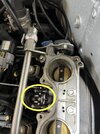Hi Group,
I just returned from a long road trip, and on the return leg, F1 lit up, and I worked out it was error code 26 (2 long flashes, 6 short). From what little I have read, this could indicate the ECU?
Thing is, the bike ran like a top, even with the F1 light on. It would not illuminate after a restart, and I could run at lower speeds without it showing up, but as soon as I got much above 55mph, it would come back on. No change in operation.
She's recently started to idle really high at cold start up - 2500 rpm, or a bit more, and takes 10 or more minutes to settle into a proper idle speed. Not sure if that could relate to the above.
Any thoughts/advice would be very much appreciated!
Thanks!
I just returned from a long road trip, and on the return leg, F1 lit up, and I worked out it was error code 26 (2 long flashes, 6 short). From what little I have read, this could indicate the ECU?
Thing is, the bike ran like a top, even with the F1 light on. It would not illuminate after a restart, and I could run at lower speeds without it showing up, but as soon as I got much above 55mph, it would come back on. No change in operation.
She's recently started to idle really high at cold start up - 2500 rpm, or a bit more, and takes 10 or more minutes to settle into a proper idle speed. Not sure if that could relate to the above.
Any thoughts/advice would be very much appreciated!
Thanks!

